Photoelectric sensors are contactless sensors that use visible or infra-red light to detect objects. They emit light beams and observe the beam for any interruptions or changes to detect the presence of any foreign object within the lightpath.
This article aims to give you an overall understanding on different types of photoelectric sensors and their method of operation.
What is a Photoelectric Sensor?
A photoelectric sensor is an optical sensor which consists of a light source, light receiver and a signal processing and control output circuitry. They can detect the presence of objects and sometimes even the surface conditions as well.
When the emitted light is interrupted by an object in close proximity, the light receiver detects this change and turns the output of the sensor on or off. Some proximity sensors are even able to determine the distance to the object as well.
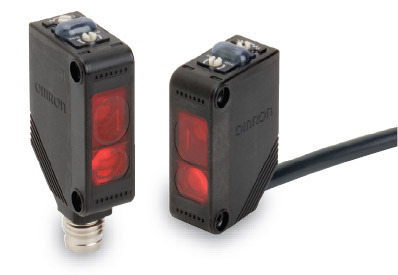
Operating Principle of Photoelectric Sensors
The operation of photoelectric sensors is based on the primary properties of light: intensity, propagation direction, frequency and polarization. They may utilize one of more of these concepts to detect and measure the distance to objects.
Properties of Light
Rectilinear Propagation
Light is an electromagnetic wave. One of the physical properties of electromagnetic waves is rectilinear propagation. It describes the tendency of light to travel in a straight line. When traveling through a homogeneous medium (material that has same properties at every point) such as air, light waves do not bend therefore they travel in straight lines.
Sensors such as through-beam photoelectric sensors use this property of light to detect objects that come across the beam, blocking it.

Refraction
Another property of light is that it changes direction (deflects) when it passes through an interface which separates two mediums. For example, when light travels through air and enters into water, the straight beam deflects. This is due to the change in the refractive index in the two mediums. The figure below shows how light refracts when it’s passing through air-glass-air mediums.
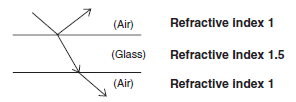
Reflection
Reflection is the property of light which describes the phenomenon where a light beam hits an object or a surface such as a glass or mirror, and redirects the beam back towards the source. Reflection describes that the incident angle is equal to the reflection angle, which makes the light beam travel in the same exact path in the opposite direction after reflecting.
Retroreflection is an improved version of reflection, where a ‘corner-cube’ is used. Corner cubes are made of three flat mirrors perpendicular to each other. This reflection is also known as ‘retroreflection’

While reflective surfaces almost fully reflect the light directed towards them, some materials like white paper can reflect light in all directions. This is called ‘scattering’ or ‘diffusion’.
Polarization
As we mentioned, light is an electromagnetic wave. Electromagnetic waves can also be seen as oscillating waves, both horizontally and vertically. Most of the photoelectric sensors use LEDs as their light sources nowadays. The light emitted by LEDs has both horizontal and vertical components, known as ‘‘unpolarized’ light.
We can use special filters called ‘polarization filters’ to filter out one of those components to make the beam only have either horizontal or the vertical oscillating components. The light beam then becomes ‘polarized’.
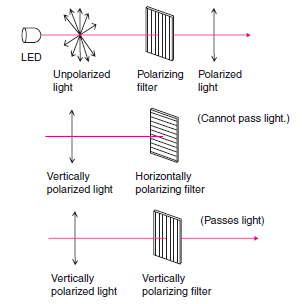
Polarization is generally used to prevent external interference as the sensor will not respond to just about any light beam, but only to the specially filtered beam.
Light Sources
Optical/photoelectric sensors come with two types of light sources: pulse modulated light and non-modulated light.
Modulated light sources
Also known as pulse-modulated light, this method uses a continuously pulsating beam of light to detect objects. The light emitted (LED) is turned on and off repeatedly at a fixed time interval. This method is highly useful in sensors where external light interference can be a problem. As the sensor is only sensitive to the specific frequency of the emitted light, external light sources cannot interfere with the sensor and trigger it accidentally.
Sensors with modulated light sources also have a higher range than sensors with non-modulated light sources.
Non-modulated light source
Being the simplest, non-modulated light is a continuously on beam that has a specific light intensity. They are faster than modulated light sensors, but are prone to external interference.
Triangulation
In distance-settable sensors, we can detect the displacement of an object using a method called ‘triangulation’. These sensors have a special sensing element which can sense where exactly the light beam falls on the sensor. For example, if the object is at the position A shown in the figure below, the light beam will fall at position ‘a’ on the position detector. If the object is moved further towards point B, the light beam will also be concentrated to point ‘b’ on the sensor.
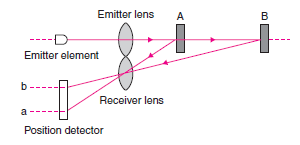
Classification of Photoelectric Sensors
We can classify photoelectric sensors using three main criteria: sensing method, selection points by sensing method and configuration.
Classification by Sensing Method
- Through-beam Sensors
- In through beam sensors, there are two devices: the emitter and the receiver. They are installed opposing each other. The emitter emits a light beam and it falls onto the sensor on the other side. When an object enters the line of sight of the sensor, it interrupts the beam and the sensor interprets the absence of light as the detection of an object.
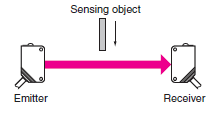
-
- Through beam sensors can have a sensing range from a few centimeters to a few tens of meters. They can detect almost any opaque material regardless of shape, color and gloss.
- Diffuse-reflective Sensors
- Diffuse reflective sensors have all the necessary hardware contained in a single housing. During normal operation, the emitter emits a light and it never returns back to the sensor. When an object is placed in the beam, it reflects some of the light back to the sensor. The sensor monitors the reflected amount of light and if it is more than a fixed value, the output is triggered.
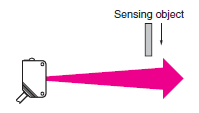
-
- Diffuse sensors are easier to mount since there is only a single device and needs little calibration/adjustment. They can detect objects from several centimeters to several meters.
- The color and texture of the objects detected can affect diffuse mode sensors’ performance and stability.
- Retro-reflective Sensors
- Retro-reflective sensors are also single-device sensors that both emit and detect the reflected light. A special reflector called ‘retroreflector’ reflects the emitted light.
- When an object interrupts the light beam, the reflected beam’s intensity becomes lower and the sensor can detect this change and turn the output on/off.
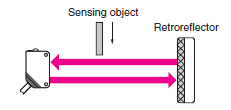
- Retroreflective sensors also have a sensing distance from a few centimeters to several meters. They can detect both transparent and opaque materials. With special additions like polarizing filters, they can even detect surfaces with a mirrored finish.
- Retroreflective sensors have a dead-zone in close ranges, which can be a disadvantage in some applications.
- Distance-settable Sensors
- Distance settable light beam sensors can detect the relative movement of a detected object. They have a position detector sensor, which can detect where on the sensor the received light concentrates. Some sensors have a 2-part photodiode, where one can detect when the object is near the sensor and the other detects when the object is far from it by calculating the difference of the light intensities given by the two photodiodes.
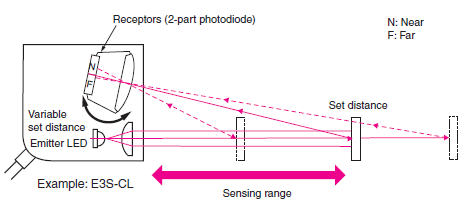
-
- Distance settable sensor operation is not greatly affected by the background or object conditions like color or surface conditions.
- Limited-reflective Sensors
- Limited reflective sensors are similar to the distance settable sensors, but their range is more limited optically. They can only detect objects in a specific distance (area where emitted light and reception path overlap).
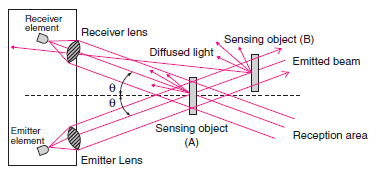
-
- Limited reflective sensors can detect small changes in height of objects, hence are suitable for quality control applications. Similar to distance settable type, sensor operation is not greatly affected by the background or object conditions like color or surface conditions.
Selection Points by Sensing Method
We need to consider multiple points when considering a photoelectric sensor for a particular application.
When selecting a through-beam and retro-reflective sensors, consider the following points:
Sensing object
- Size and shape (length x width x height)
- Transparency (opaque, semi-transparent or transparent)
Sensor
- Sensing distance
- Size and shape restrictions (sensor and any reflectors)
- Need for side-by-side mounting
- Number of units
- Mounting pitch
- Need for staggered mounting
- Mounting restrictions
- Angle
- Clearance
Environment
- Ambient temperature, humidity
- Presence of splashing water, chemicals and oil
If the application requires a diffuse-reflective, distance settable or a limited-distance settable sensor, check for the characteristics of;
Sensing object
- Size and shape (length x width x height)
- Color
- Material (steel, wood, paper, SUS etc.)
- Surface finish (gloxxy, textured etc.)
- Travelling velocity
Sensor
- Sensing distance
- Size and shape restrictions (sensor and any reflectors)
- Need for side-by-side mounting
- Number of units
- Mounting pitch
- Need for staggered mounting
- Mounting restrictions
- Angle
- Clearance
Environment
- Ambient temperature, humidity
- Presence of splashing water, chemicals, and oil
Classification by Configuration
Photoelectric sensors can also be categorized according to their physical configuration. They have four main parts, the Emitter, Receiver, Amplifier and Controller.
Sensors with Separate Amplifiers
Sensors like through-beam type photoelectric sensors often have their amplifier circuit as a separate unit. For through beam type, the Emitter and Receiver are also housed in different housings. Reflective sensors have an integrated emitter and receiver, along with a separate amplifier unit.
This arrangement can be useful where the sensors need to be mounted in tight spaces and will not be easily accessible to adjust their sensitivity. However, since the amplifier is mounted away from the sensors, the signal is also susceptible to electrical noise.
Built-in Amplifier Sensors
This type consists of all four main components of the sensor, including the amplifier unit. Most of the through beam sensors with integrated amplifiers have the receiver, amplifier and the controller built-in to the receiver and the emitter stays as a separate unit. They only require external power to power up.
Built-in amplifier sensors need relatively less amount of wiring than the ones without the amplifiers. So they are very less likely to be affected by electrical noise because there are no signal wires involved.
Sensors with built-in Power Supplies
This type of photoelectric sensors can directly drive a high power load like motors or light bulbs. They have their own power supply circuitry built-in and can be directly connected to commercial power supplies. (no need for separate power supply units).
However, they are also much larger in terms of the footprint since they need to contain all the power electronics and power supply circuit in addition to the emitter, receiver, amplifier and the controller circuit.
Area Sensors
Area sensors are a modified version of through-beam sensors that can detect objects using multiple beams. They are useful when detecting objects that can have varying heights of orientation such as small parts.
Features of Photoelectric Sensor
The most useful feature of photoelectric sensors is that they can sense any object without making any contact. Unlike sensors such as limit switches, they detect the presence of an object using light. They also have no restrictions as to what can be detected; the right photoelectric sensor will detect any object within its sensing limitations.
Photoelectric sensors are also extremely fast and have very high resolution for precision applications. They also have the highest sensing range, spanning over 10 meters when compared to magnetic and ultrasonic counterparts.
Aligning, calibrating and adjusting photoelectric sensors is also very easy since the light beam is visible to the naked eye (only for models that emit visible light).
Photoelectric Sensor Sensitivity Adjustment
Adjusting the sensitivity of photoelectric sensors is very straightforward. Some sensors consist of a special button called ‘teach-in’ and the others come equipped with a potentiometer that we can turn using a screwdriver. A typical photoelectric sensor has two indicator LEDs, a green one for power indication and an orange one for indicating the current output status.
To adjust the sensitivity of the potentiometer type, fully turn the potentiometer counter-clockwise when no object is present. Then place the object in front of the sensor and turn the potentiometer clockwise until the orange LED lights up.
Where are Photoelectric Sensors Used?
Photoelectric sensors are found in many contact-less object detection applications. They include,
- Checking and counting objects traveling down a conveyor line
- Detecting colours
- Measuring distances
- Measuring displacement
- Proximity sensing (presence/absence of an object)
What is the difference between Proximity Sensors and Photoelectric Sensors?
Proximity sensors typically use electromagnetic or capacitive fields to detect the presence of objects. Photoelectric sensors use light beams to detect objects. There are proximity sensors that use light beams for sensing.
Photoelectric sensors are extremely fast when compared to proximity sensors as they use light beams to detect objects. This is because light travels at very high speeds. Proximity sensors may take upto a few milliseconds to properly detect an object.
Proximity sensors are relatively lower cost than their photoelectric counterparts. This is due to relatively simple construction of the proximity sensors. But proximity sensors are generally larger than photoelectric sensors.
Photoelectric sensors are more complex than proximity sensors, but they also have very high resolution and accuracy. Photoelectric sensors are also easier to adjust than proximity sensors, which require additional calibration material sometimes.
What are the four basic parts of the photoelectric sensor?
There are four main stages of a photoelectric sensor:
Light Source
This is the section which handles the light emitting. Present day photoelectric sensors are based on LED (Light Emitting Diodes) that can have either infrared (IR) or visible light like red, green or blue colour. Most sensors use the pulse-modulated method to send burst of continuous pulses to reduce external interference caused by similar light sources.
Light Receiver
The receiver circuit receives the reflected/emitted light from the light source and converts it into an electrical signal.
Main Circuit
The main circuit handles all the high level functions like pulse modulation for the emitter and signal conditioning for the receiver. It also has a synchronous detector and an amplifier stage to detect the presence/absence or a change in the received signal.
Output Circuit
The output circuit controls the final output signal. There are all types of output circuits available including NPN/PNP outputs and relay outputs. Some sensors may output analog signals and some can even drive a considerably large load directly instead of providing only a signal.
How do you set-up a Photoelectric Sensor?
Photoelectric sensors are available in multiple output types including transistor-output such as PNP or NPN and relay out. The figure below indicates the wiring of the emitter unit for a through beam sensor. Supplying 0V to the pink wire will turn on the emitter.
The receiver of the through beam sensor shown below has NPN type outputs. The black output stays at high voltage (12V or 24V based on the supply). When an object is detected, it is connected to 0V, causing the current to flow through the load connected. To interface with NPN type sensors, a PLC needs to have a PNP type input card.
Conclusion
In this article, we discussed the general operation of photoelectric sensors, the technology behind their operation and the types of sensors that are available in the industry. Photoelectric sensors are highly accurate and precise sensors that are used in high-precision machines and general applications to detect objects.